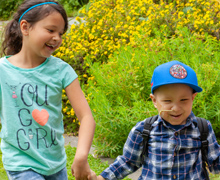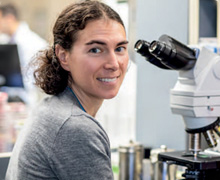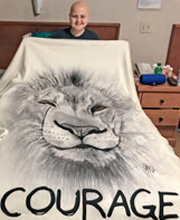All In Against Leukemia
Our High-Risk Leukemia Program leaves no stone unturned to help hard-to-treat kids win a race against time.

Jimmy Now, 4, joins his sister, Lauren, on a short stroll – his first trip outdoors in nearly five months after being treated for leukemia with a stem cell transplant. Like many patients with hard-to-treat leukemia, Jimmy later relapsed and returned to Seattle Children’s to prepare for a second transplant.
Decades of work to improve leukemia care is paying off. Nearly 90% of children with the most common form of leukemia – acute lymphocytic leukemia (ALL) – are cured by today’s standard therapies. Yet there are still many children whose leukemia is beyond the power of standard care.
These children are in a race against time to find effective treatment.
“It's hard to hear your child may not survive,” says Samantha Now, whose son Jimmy, 4, is fighting acute myelogenous leukemia (AML) that is resistant to treatment. “You don't know how much longer you're going to have with them.”
Kids like Jimmy need a highly personalized approach to figure out what is different about their leukemia and to find (or even develop) an effective treatment as quickly as possible.
“Their lives depend on leaving no stone unturned,” says cancer specialist Dr. Todd Cooper.
That’s why Cooper formed the High-Risk Leukemia Program at Seattle Children's last year. High-risk leukemia is the medical name for leukemia that is harder to treat and more likely to come back after treatment.
A team approach
The new program surrounds each patient with a carefully chosen team of leukemia experts and other specialists drawn not only from Seattle Children’s and Fred Hutchinson Cancer Center. Dr. Marie Bleakley of Fred Hutch co-directs the program.
“Few places in the world can lay claim to greater expertise in leukemia treatment and research than Seattle,” Cooper says. “We bring all of this expertise to bear on trying to cure every child.”
The program coordinates all aspects of a child’s care. Patients see their cancer doctor and a transplant doctor (many high-risk patients need stem cell transplants) at the same time rather than separately as is the norm. Patients and families also see other important members of their care team, such as heart doctors and infectious disease specialists, during the same clinic visit.
After seeing patients and families, the clinical team gathers to compare notes – including results from personalized genomic testing – and develop an individualized treatment plan. The entire process repeats itself at key milestones in each patient’s treatment journey as the team tracks progress and makes any needed changes.
“This is a paradigm shift in leukemia care,” Cooper says. “No other pediatric leukemia program that I know of gathers all of a child’s providers under the same roof at the same time, but it helps us look at patients from every angle and provide the best possible care every step of the way. Plus, it makes life easier for families, who have enough on their plate without having to juggle appointments with different providers on different days.”
Precision medicine

By studying how to target the mutations that drive each patient’s leukemia, Dr. Katherine Tarlock works to match kids with therapies that target the Achilles heel of their hard-to-treat cancer.
Leukemia is cancer of the blood. Until recently, doctors made little distinction between types of leukemia other than to differentiate between ALL and AML, leading to a one-size-fits-all approach to treatment that fails to help all kids.
Seattle Children’s is among the leaders in changing that.
“We used to think that AML is AML and ALL is ALL,” says cancer specialist Dr. Katherine Tarlock. “But thanks to advances in gene sequencing technology and our improved ability to interpret the results, we can now pick up genetic clues that one child with AML or ALL has a different type of the disease than another.”
Sequencing is not always part of initial leukemia treatment. But every child who comes to the High-Risk Leukemia Program has their leukemia sequenced to identify mutations and determine their cancer’s genetic signature. Their cancer cells are also examined for certain telltale proteins that can serve as targets for new therapies.
All of this information enables the experts to detect an individual profile that helps them match patients with therapies aimed at their form of leukemia – a practice known as precision (or personalized) medicine.
“These are complicated patients who’ve often been through several rounds of grueling therapy that hasn’t worked,” Tarlock says. “The more we understand about what drives their particular leukemia, the better we can predict their response to treatment and find or develop therapies that attack the Achilles heel of their disease.”
Access to hope
Most kids who come to Seattle Children’s for high-risk leukemia treatment join one of our many clinical trials for new therapies. Access to these promising but still unproven treatments offers immediate hope to children who are running out of time and options.
Cooper expects families from around the world to travel to Seattle Children’s in search of the best possible care. “Over time we will collect an unprecedented amount of clinical and biologic information about high-risk leukemia that will help researchers improve already developed therapies and plant the seed for new ones,” he says.
One of the most exciting examples of current research is a study looking at how to reprogram a patient’s own T cells to seek out and permanently destroy cancer in patients whose leukemia cells express certain proteins.
Known as chimeric antigen receptor (CAR) T-cell immunotherapy, this approach could lead directly to a cure for some children while enabling others to potentially be cured through a stem cell transplant.
Removing barriers
A stem cell transplant is the only known treatment for many children with high-risk leukemia – especially those with AML. But these kids face unique barriers to a successful transplant.
High-intensity “conditioning” drugs are used to kill all the leukemia cells and prepare patients for a transplant, but the drugs often don’t work well and/or fail to stop the leukemia from returning after transplant. When a transplant fails, patients have no choice but to try again, but each transplant leaves their body less able to tolerate high-intensity drugs.
Many of the leukemia studies underway at Seattle Children’s involve alternatives – like CAR T-cell therapy and others – that help kids overcome transplant barriers.

After two failed stem cell transplants, Ashtyn Poulsen’s five-year battle against leukemia led her to Seattle Children’s, where she underwent a third transplant that relied on new and potentially more effective therapies to eliminate the cancer cells and prepare her for transplant. “We are definitely on a roller-coaster ride,” says her mother, Suzanne, “but science keeps opening doors that give us reason to believe.”
Ashtyn Poulsen and her family thought she was cured of ALL twice – once after a stem cell transplant when she was 12 and again after a transplant when she was 15 – only to have their hopes dashed when she relapsed each time.
Ashtyn’s doctors in Salt Lake City referred her to Seattle Children’s, where she joined studies for two new drugs that proved tolerable and effective in putting her leukemia into remission and preparing her for transplant.
Ashtyn, 17, received her third transplant – this time at Seattle Children’s – in August.
After everything Ashtyn has been through, the expertise of her care team at Seattle Children’s is reassuring to her mother, Suzanne Poulsen. “I can’t say enough about how impressed I am with how brilliant these people are and how well they plan for her care,” she says. “Nothing seems to catch them off guard.”
Connection, Winter 2019